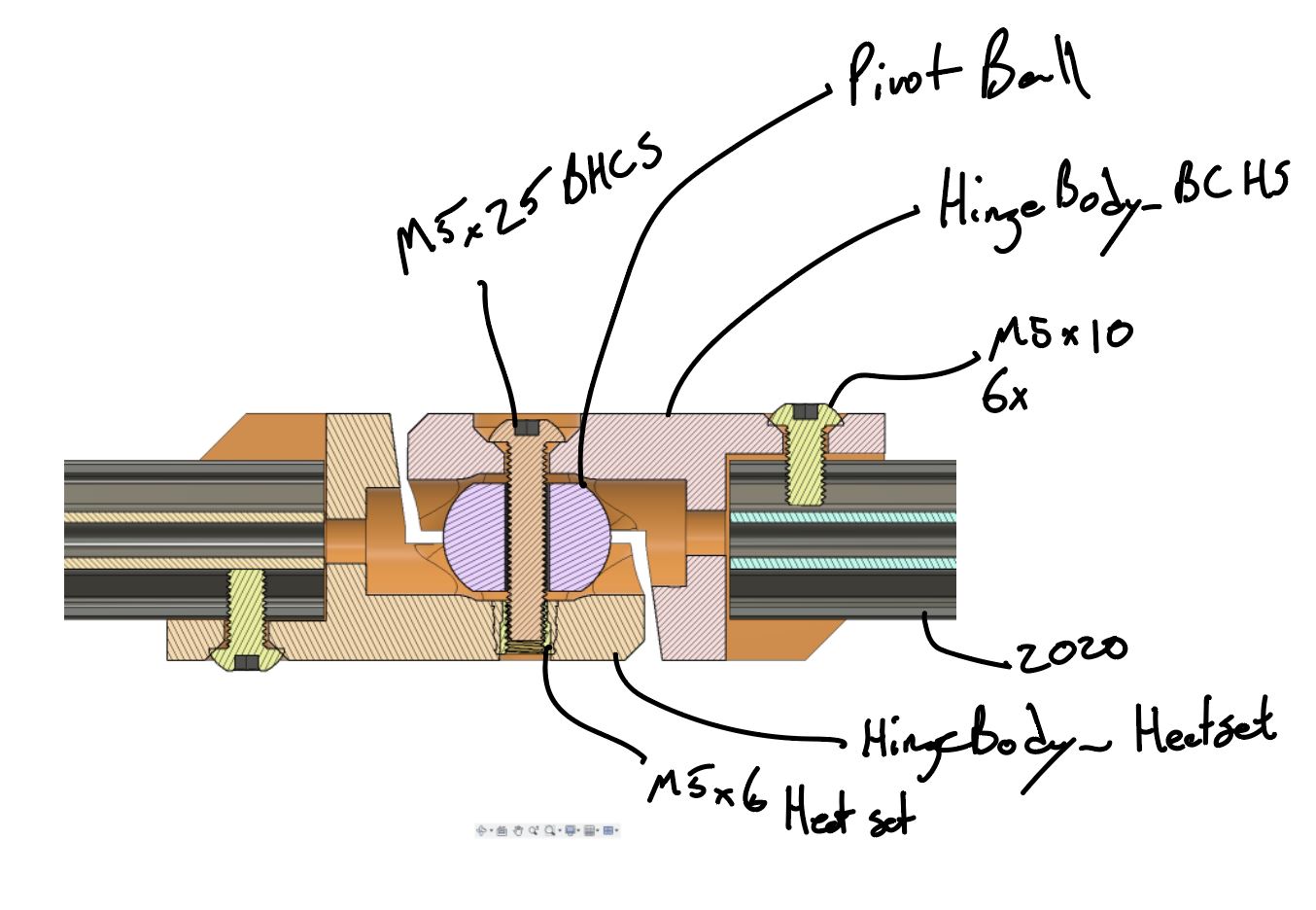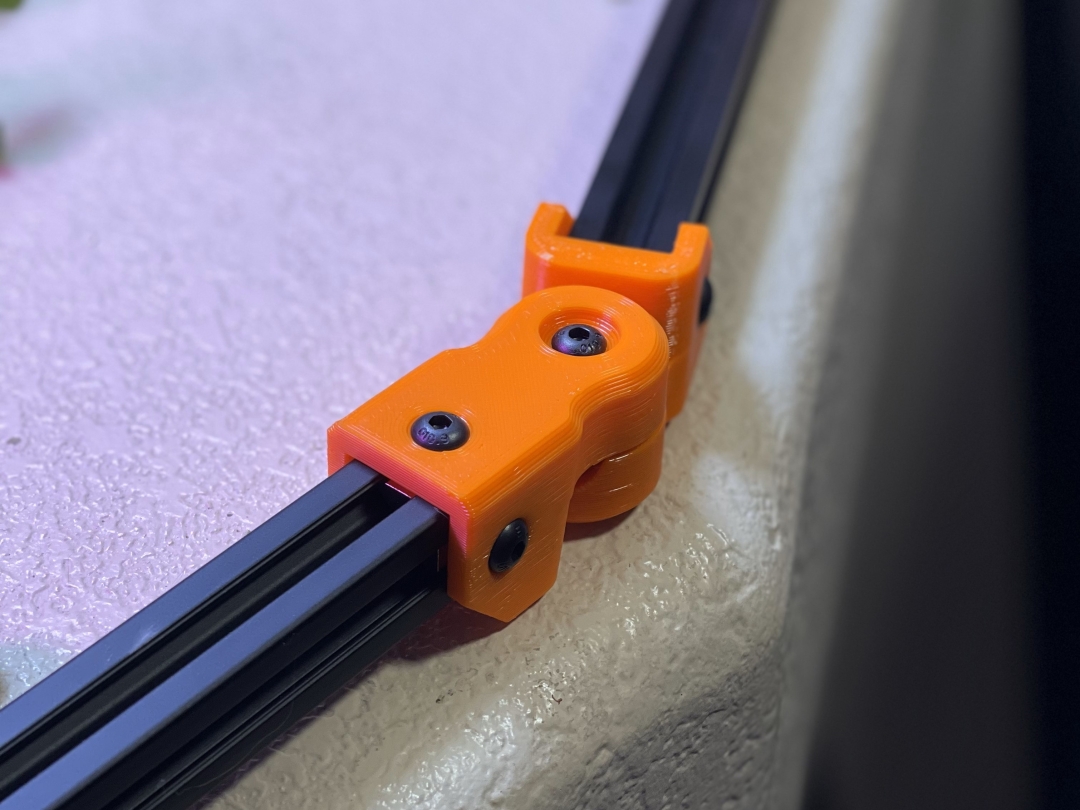BubsBuilds Projects

- Details
- Parent Category: BubsBuilds Projects
- Category: Assorted (hopefully) "Useful Stuff" Projects
I made this little pulley as part of a larger project aimed at making my resin printing workflow a bit more efficient. If it works out, I'll add a dedicated page with some details on the build.
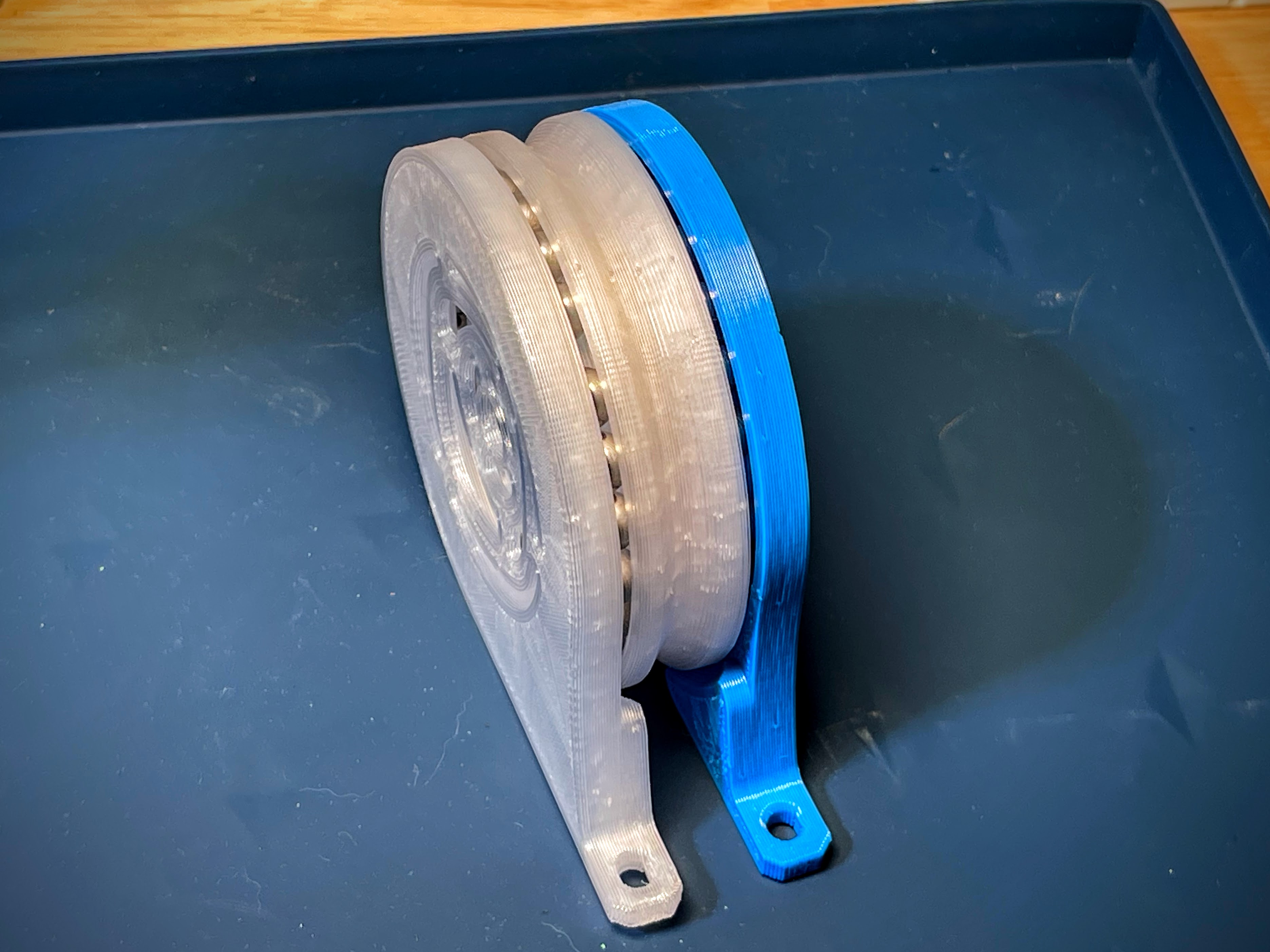
The Design
It's a relatively simple little pulley, so not a ton to dive into on the deisgn, but there are a couple of design elements that I think are fun/noteworthy.
The first is the integration of the bearing races into the printed parts. It's makes for a bumpier ride than going with rolling element bearings, but it alleviates the need for printing a 'precision' shaft for the inner bearing race, and keeps the stresses well distributed in the printed parts (instead of concentrating the stresses at the hub.)
 |
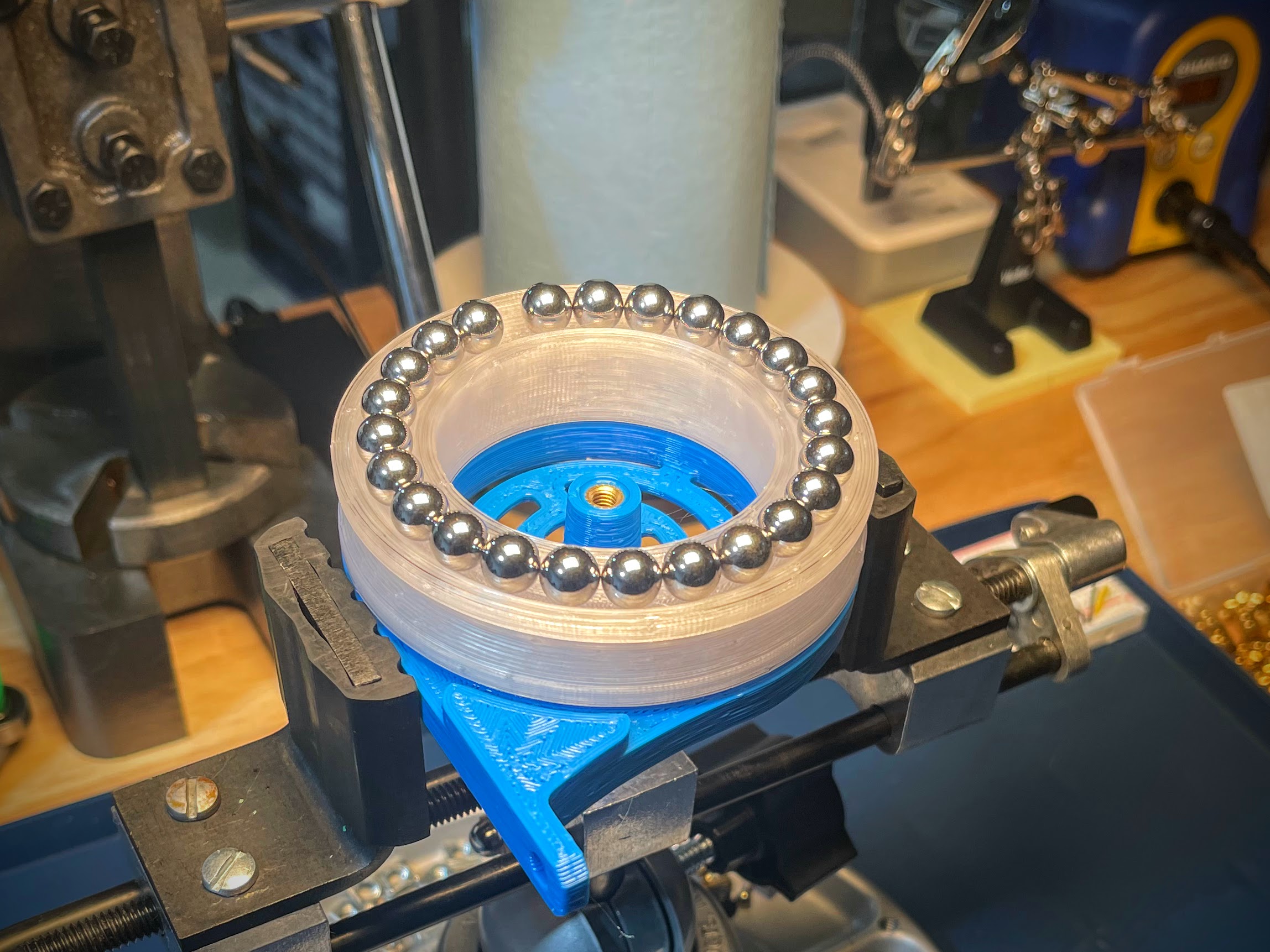 |
The second design element of note is the use of diaphragm flexures to provide a somewhat repeatable preloading of the bearing. I say "somewhat" because plastics (especially those we all tend to print with) are quite susceptible to stress relaxation. So over time the preload in the bearing is likely to decay, possibly significantly. Unfortunately, trying to accurately predict relaxation is difficult even in well-behaved metals. So I'm just gonna let it ride and see how it holds up!
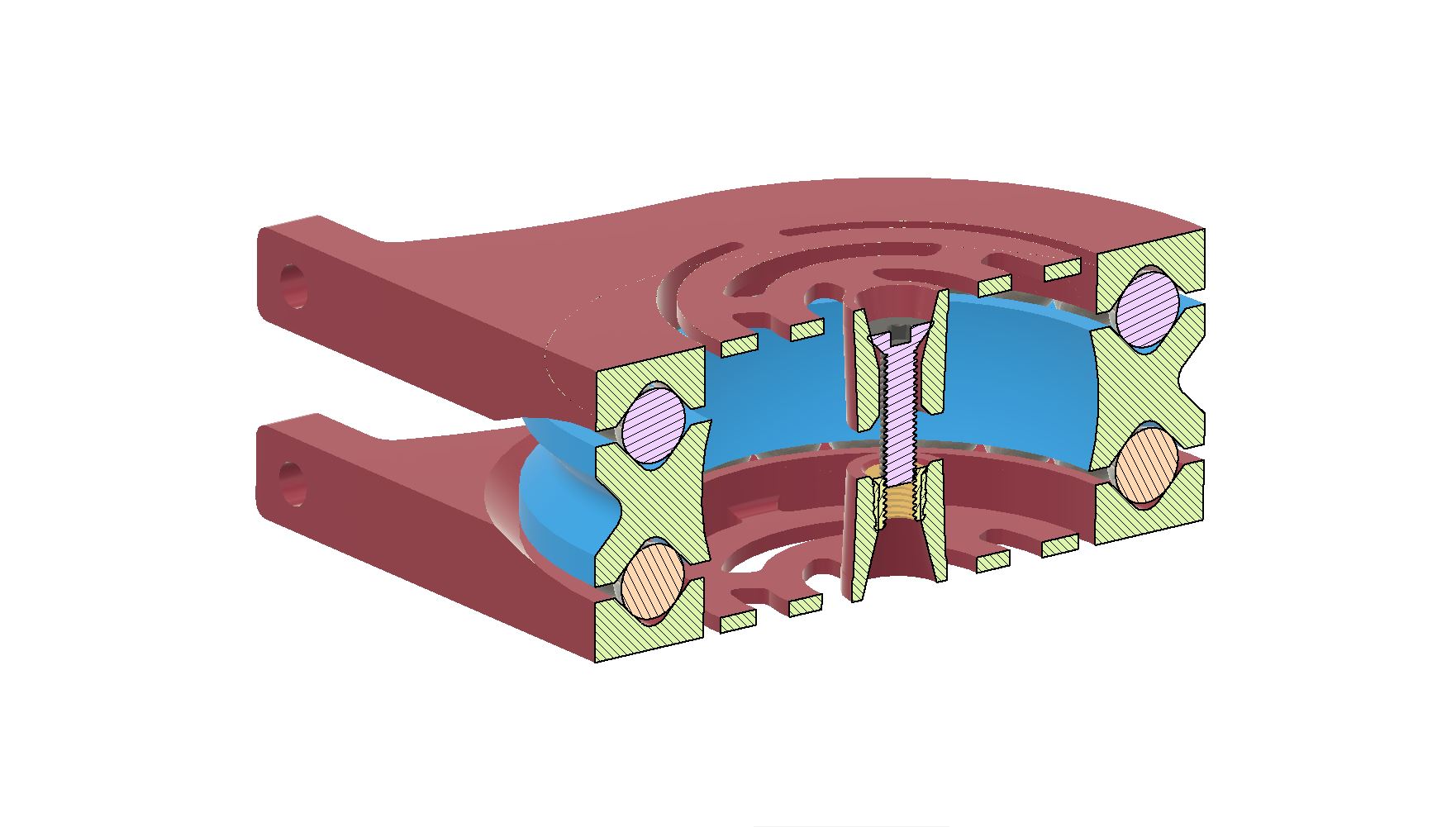 |
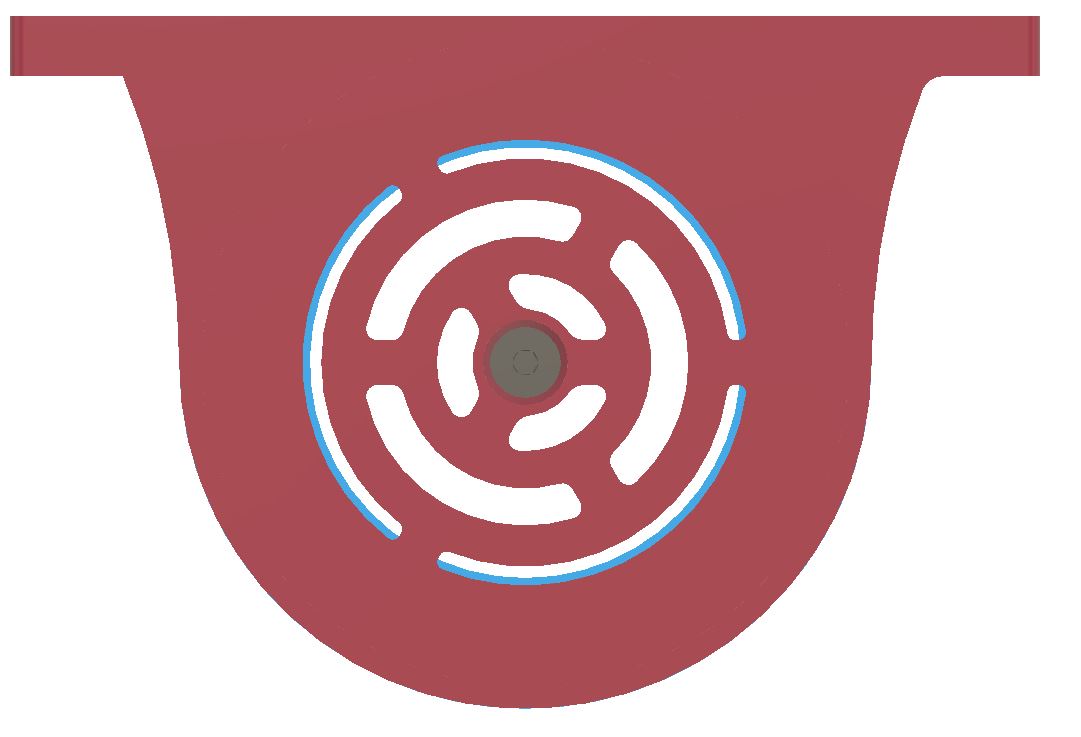 |
The preload works by tightening the M5 fastener through the center until the inner and outer hubs are fully in contact. The flexures will be displaced 1-2mm toward each other, providing the compressive force through the bearing. As a load is applied to the pulley, the V-grooves in the bearing races apply a force to separate the assembly, however, because the stiffness of these flexures is nonlinear, the preload force increases rapidly in opposition to any deflection...so my guess is, when it fails, it'll fail where the flexure meets the hub.
The Build
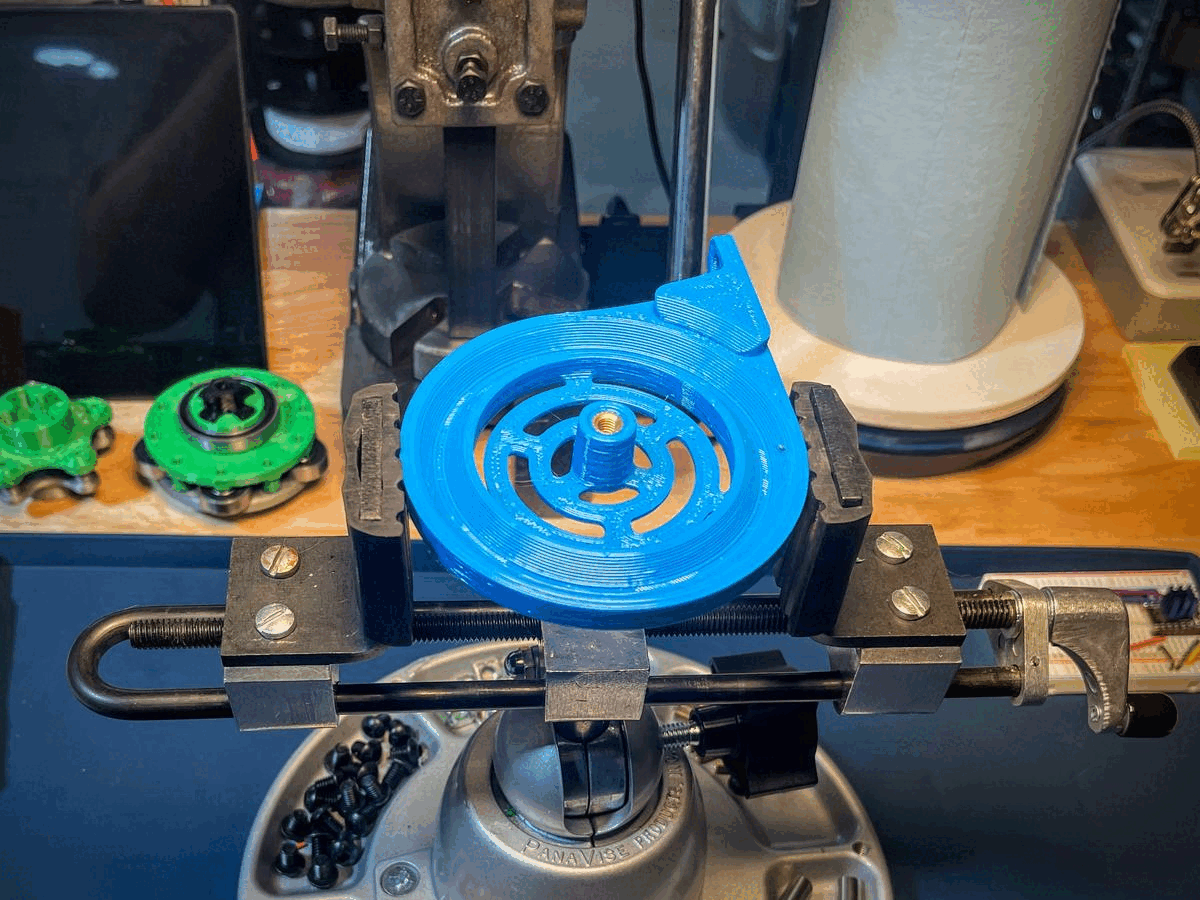
BOM:
- Printed Parts
- (Qty 2) Housing - There are two variants, one with a single mount hole per side (like shown in the GIF above) and one with two. They work the same, the choice is yours on how you want to mount it, and how brave you are with a single fastener per side.
- (Qty 1) Pulley
- COTS
- (Qty 48) 3/8" Balls - I bought this bucket of balls a couple of years ago, use them liberally (as you can see), and I still have lots left...what can I say, I like em
- (Qty 1) M5x5.8 Heat set insert
- (Qty 1) M5x20 Flat head hex socket - Head type is up to you, and anything longer than 20mm will also work.
- Lubricant - I used this dry PTFE from WD-40, but whatever your preference. You can also run it dry, but it's noticeably smoother with some lubrication.
Assembly
- I started by laying one housing flat on the table and inserting the M5 heat set.
- Put the first 24 balls into the V-groove in this housing (you don't need to count them, just put them in until the groove is full)
- Apply some lube
- Place the pulley/rotor onto the balls. The pulley is symmetric, so orientation shouldn't matter.
- Put the remaining balls into the V-groove in the pulley
- More lube
- Put on the second housing and tighten the M5 until the hubs have come into contact (you'll notice the screw torque go up REAL quick), and then tighten a smidge more...don't go crazy.
- Good to go, mount 'er and lift somethin!
- Details
- Parent Category: BubsBuilds Projects
- Category: Assorted (hopefully) "Useful Stuff" Projects
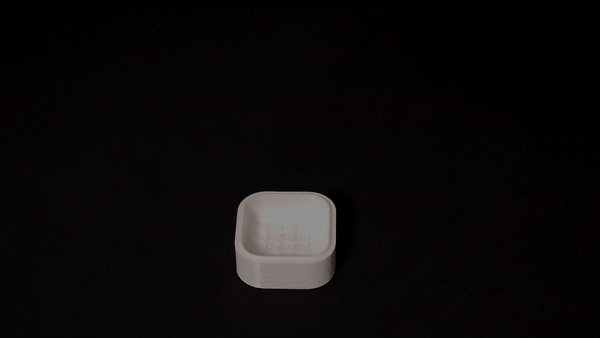 |
Every project I work on that includes fasteners seems to end up accumulating a pile of unsorted, random bolts and their buddies. Usually these piles just find their way into what will be their indefinite home...the bolt bucket. So I've long thought it would be amazing to have a contraption to handle this for me, and over the years have tried a few, shall we say, 'not so fruitful' attempts to rig something up. The last couple of months I've been playing around with trying to build something 'sieve-like' for sorting bolts by their heads. If you aren't familiar with sieves, here's an article from some random website that came up in the first few Google results ¯\_(ツ)_/¯
 |
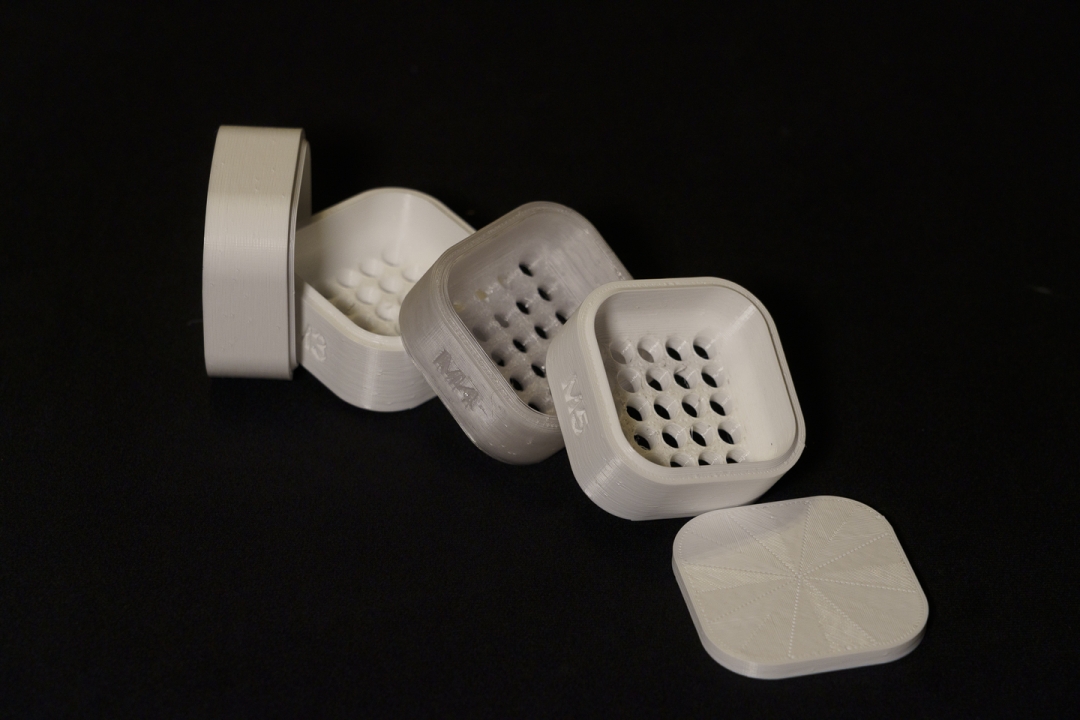 |
There's nothing too special in how it works, each layer has an array of holes. The holes of that layer are just smaller than the diameter of the head of the fastener that you want to 'capture' in that layer. The below cross-section shows the hole sizes for this 'first gen' set of screens. I selected these values based on the BHCS and SHCS head sizes ('dk' value) on the tables here.

Obviously this doesn't solve all of my sorting woes, but as you can see from the little video (is there anything worse than having to listen to your own voice?? :) ) it works pretty damn well for at least tackling this specific piece of the problem!
I printed mine from White and Clear Overture PETG, with all five parts printing on a single build plate in a little under 7 hours.
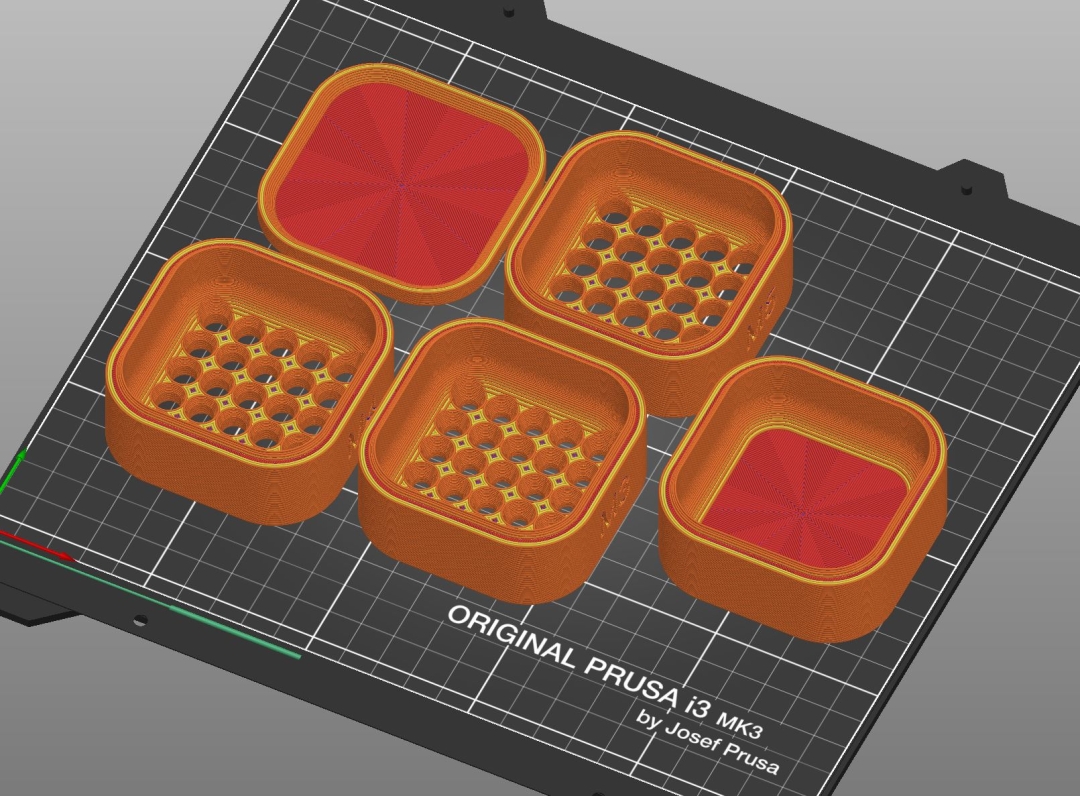
I plan to add additional screens over time, and, while I really like this little dude and have already tossed one in each of my toolboxes, I still have hopes for something that can handle the full range of crap that bolt bucket has to offer! If you have ideas for how to make that dream happen, want to suggest screen sizes that you think would be must-haves, or just want to follow along to see how it evolves, you can follow me on Printables.
Screens
BHCS & SHCS - Metric
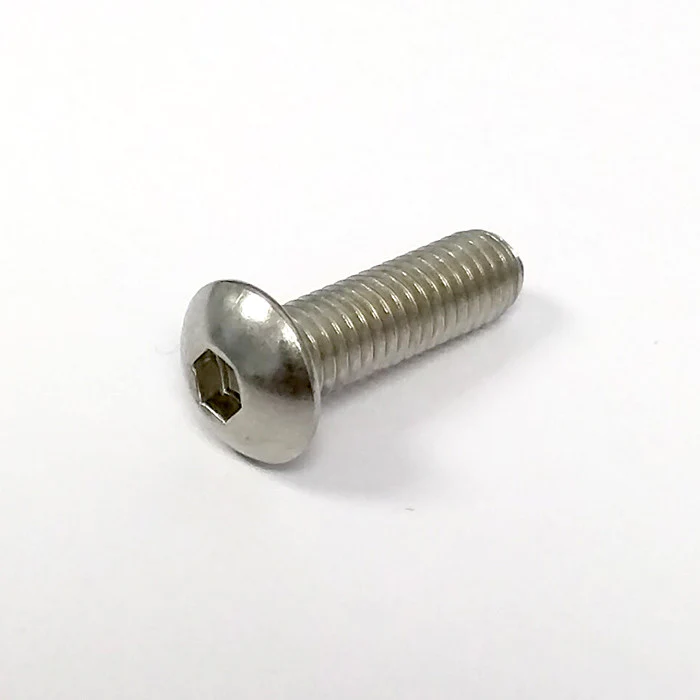



M2 - 3.6mm pores
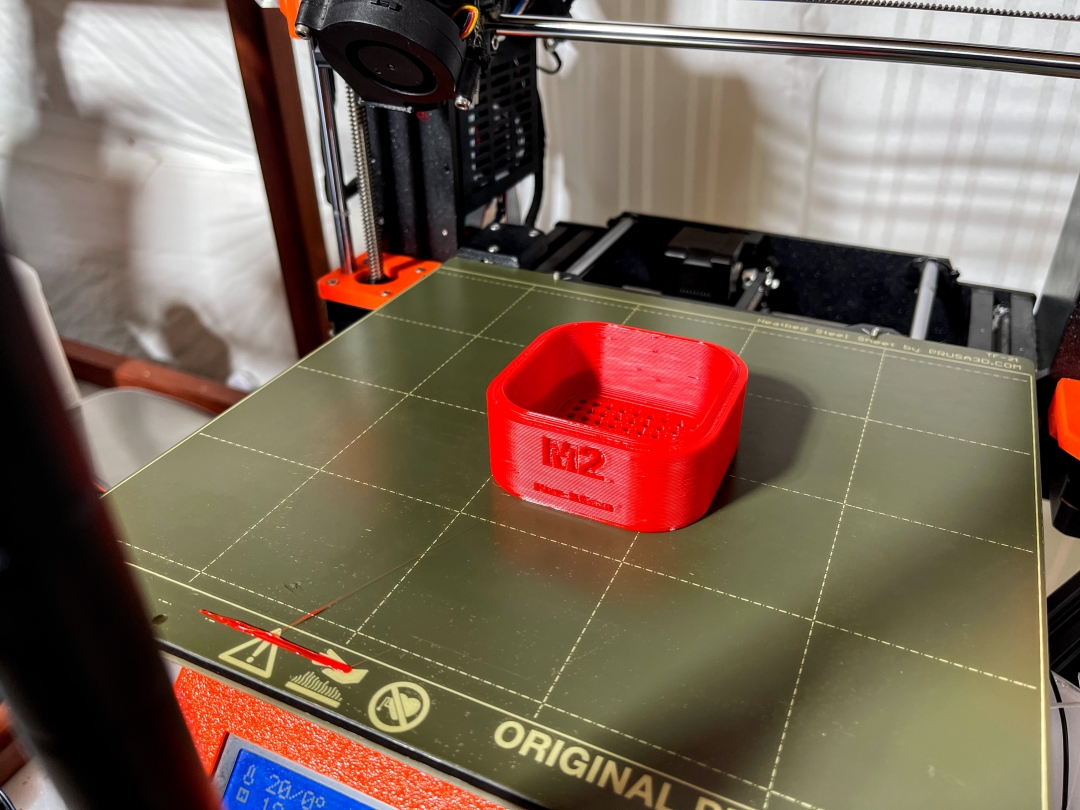
M2.5 - 4.3mm pores

M3 - 5.3mm pores
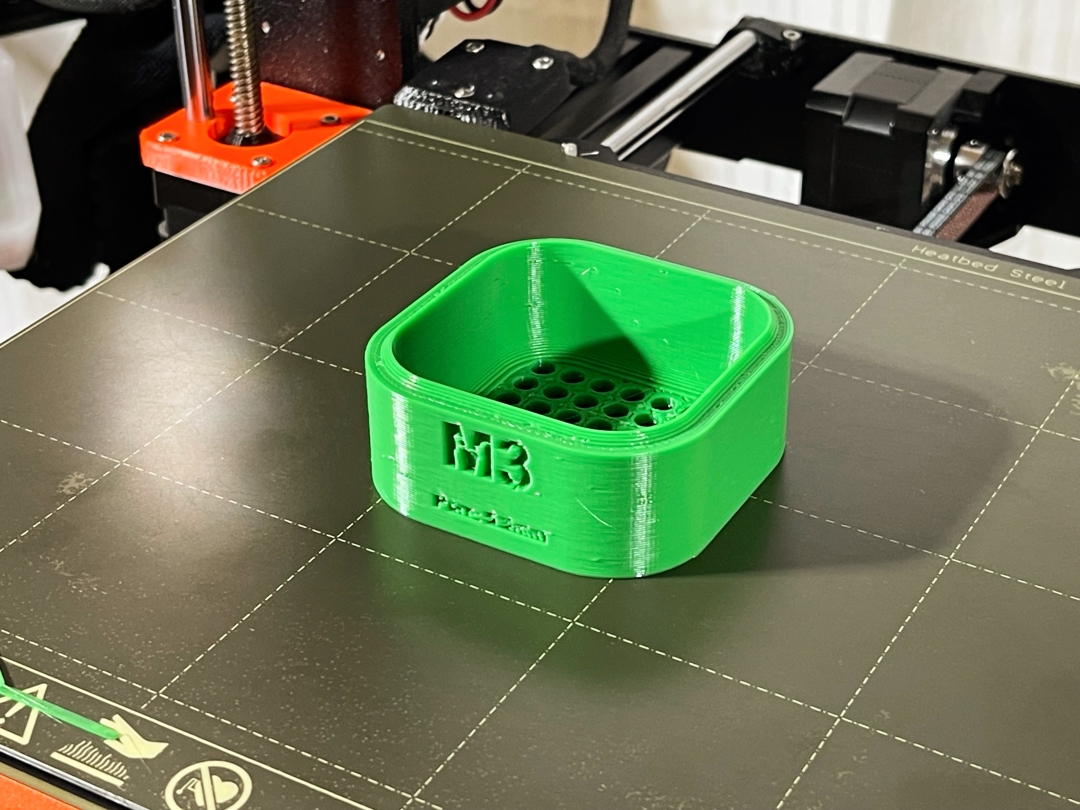
M6 - 9.7mm pores

I printed the one shown in Green Overture PETG with a 0.6mm E3D Revo nozzle.
Spacers
The spacers are intended to add some extra volume to a given 'chamber' of the sieve to allow for longer fasteners, or slightly more fasteners (ultimately going to be limited by the number of 'pores' per screen, of course.)
"Unit Cell" Spacer - 27mm
This spacer is the same height as the other (current) screens at 27mm from flat to flat.
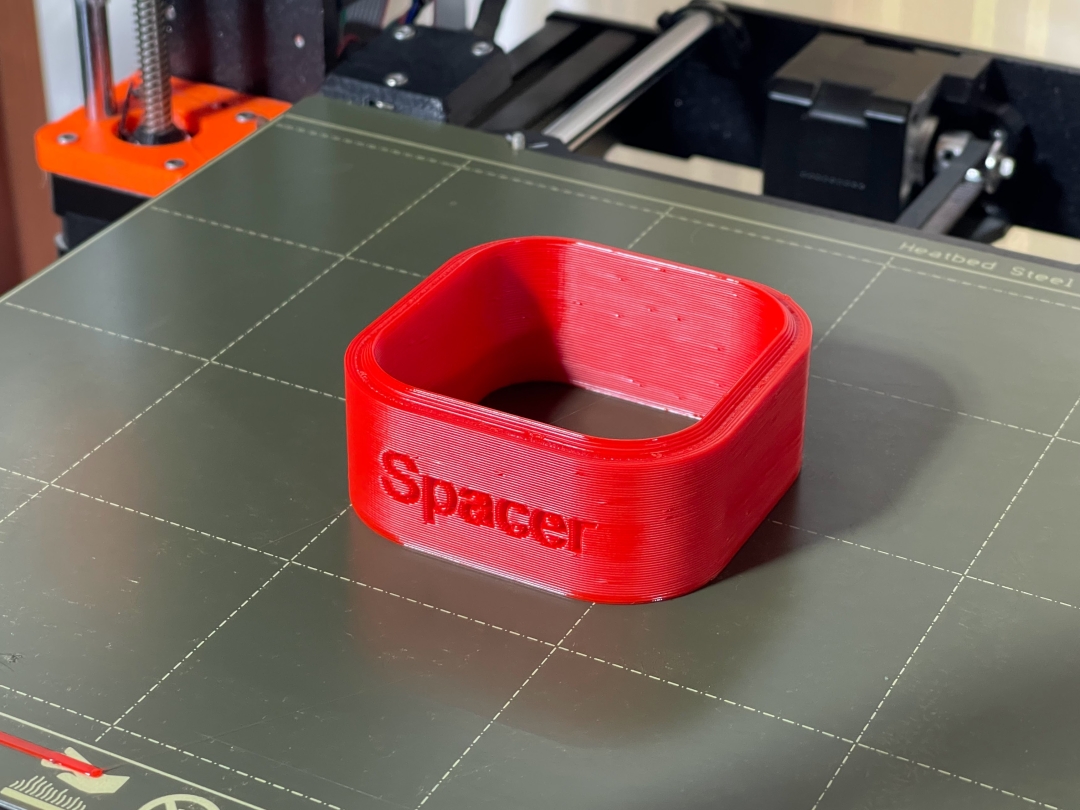
I printed the one shown in Red Overture PETG with a 0.6mm E3D Revo nozzle.
Other
No6 - "Bugle" Head...? New to me, but that's what the box says ¯\_(ツ)_/¯
I think this should work for most #6 wood screw heads, but I sized it specifically based on some wood screws I have around that I wanted to sort out.
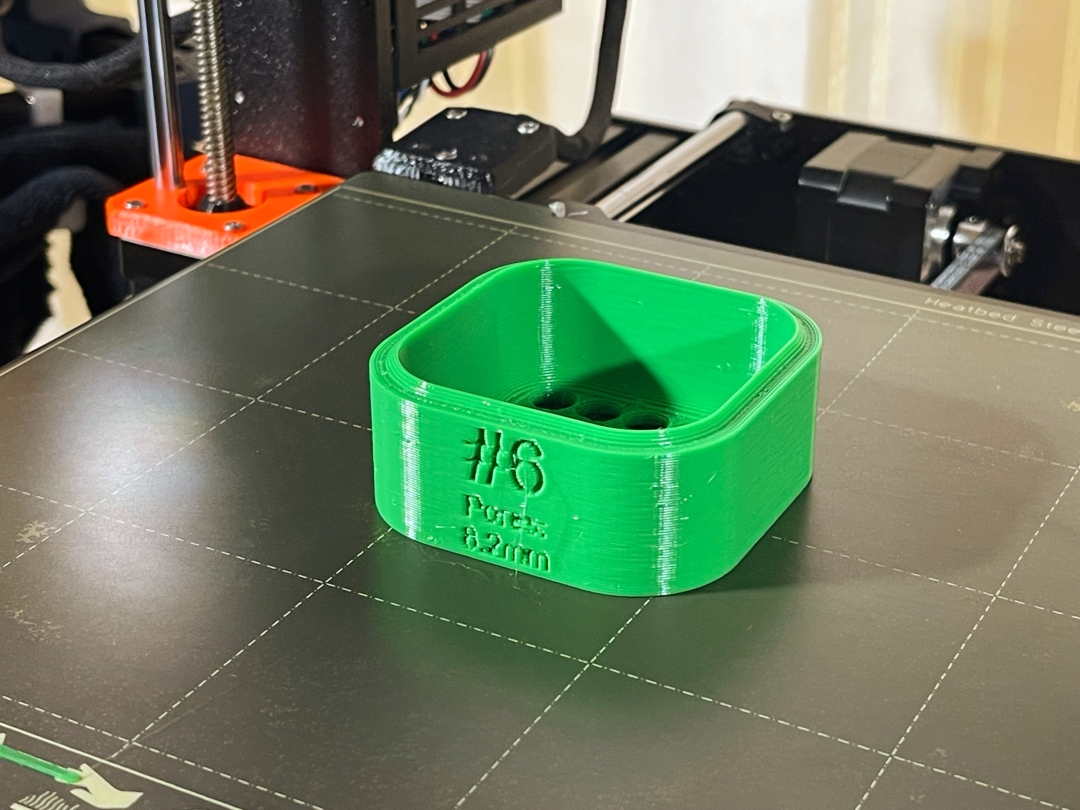
I printed the one shown in Green Overture PETG with a 0.6mm E3D Revo nozzle.
- Details
- Parent Category: BubsBuilds Projects
- Category: Assorted (hopefully) "Useful Stuff" Projects
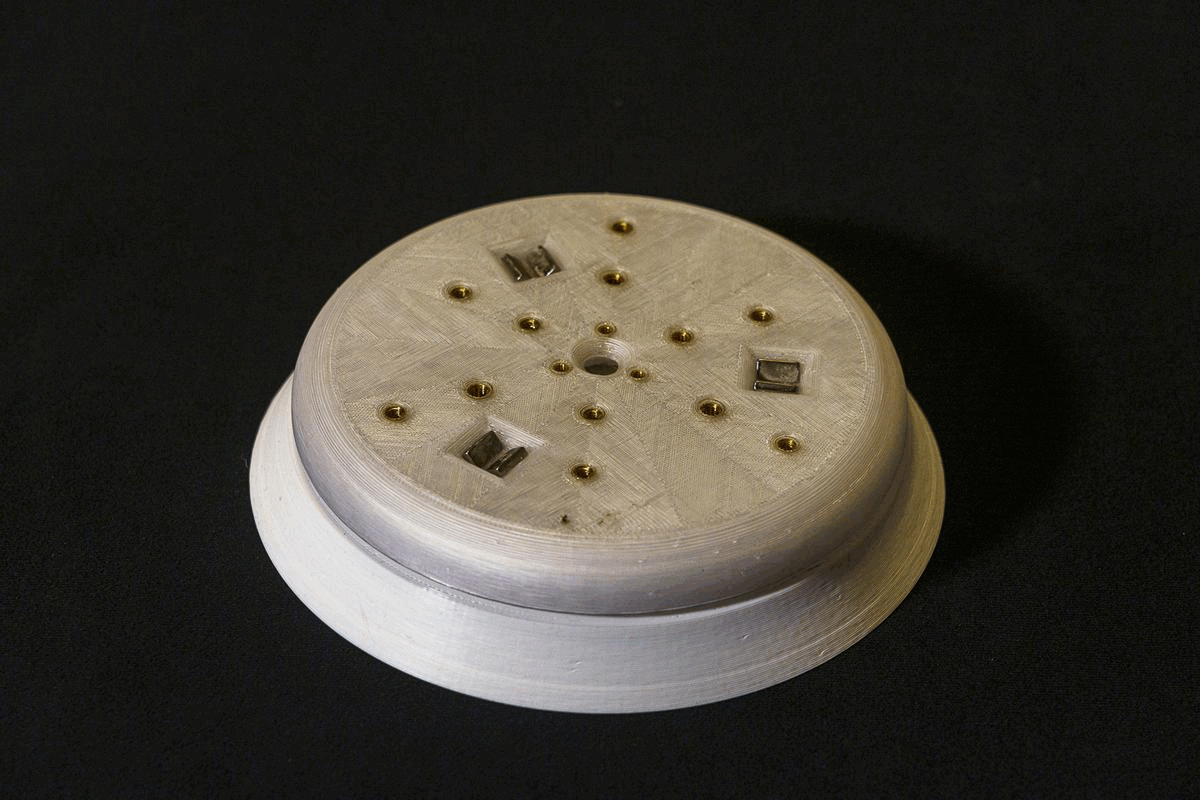
A (relatively) simple general purpose rotary turntable. Intended for any of those, "Hmm, I'd really like to spin this around" type of projects, with the various mounting interfaces on the top surface aimed at providing flexible mount options to interface to these various tasks.
 |
 |
There are V-grooves on both the Base and the Table to serve as the bearing races, and these are filled with 3/8" steel balls (or, if you play with balls as much as I do, you may want this bad boy, which I recently discovered with great glee). The grooves are sized to fit 34 balls in total, but you can use less if you'd like. However, it will be a little more noisier and less smooth, but not like you're looking for air bearing performance from your 3d printed rotary table...I hope :) The bearing is preloaded (and parts held together) with sets of 20x3 disk magnets (3 on each side).
The table has locations for a variety of mounting options, as shown in the below. These interfaces are:
- 3x M3x5.7 Heat set inserts on a 25mm circle
- 3x M4x8.1 Heat set inserts on a 50mm circle
- 3x M5x9.5 Heat set inserts on a 75mm circle
- 3x M4x8.1 Heat set inserts on a 100mm circle
- A 'Maxwell clamp'-style kinematic mount on a 100mm circle, sized for between 3/8"-1/2" (9.5-12.5mm) diameter balls. The contact points and preloads are provided by 6 of these 12x6x3 bar magnets.
- 3xM3x5.7 Heat set inserts on a 125mm circle
 |
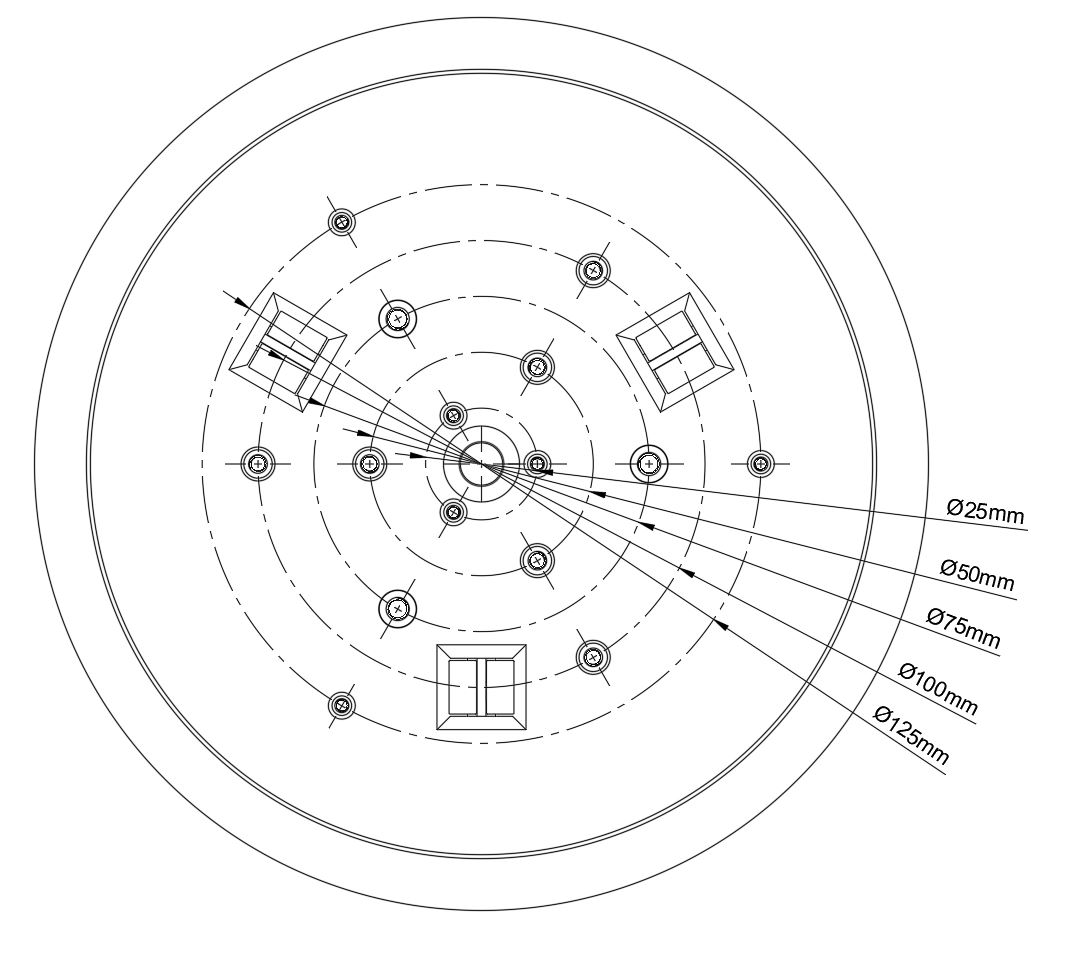 |
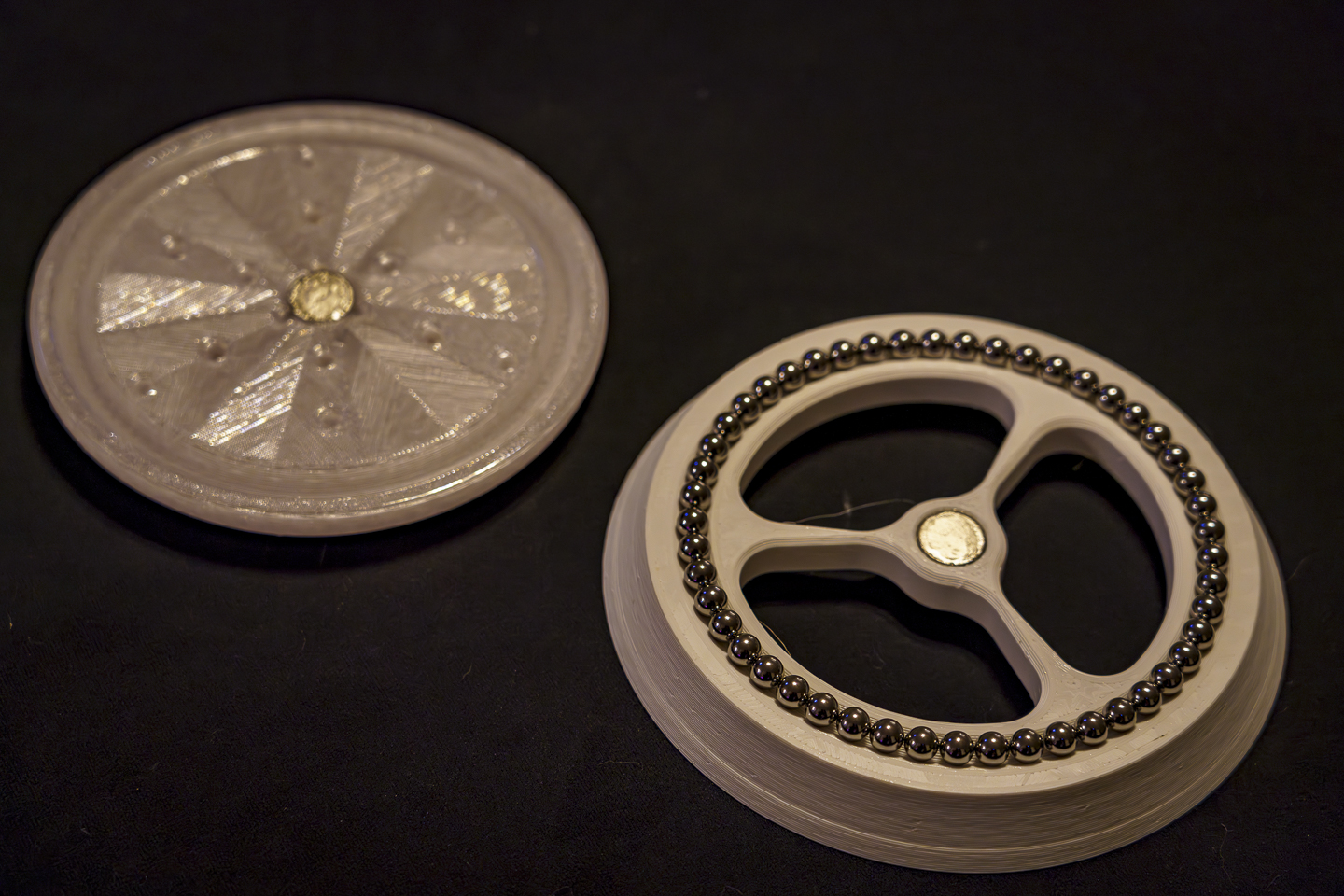 |
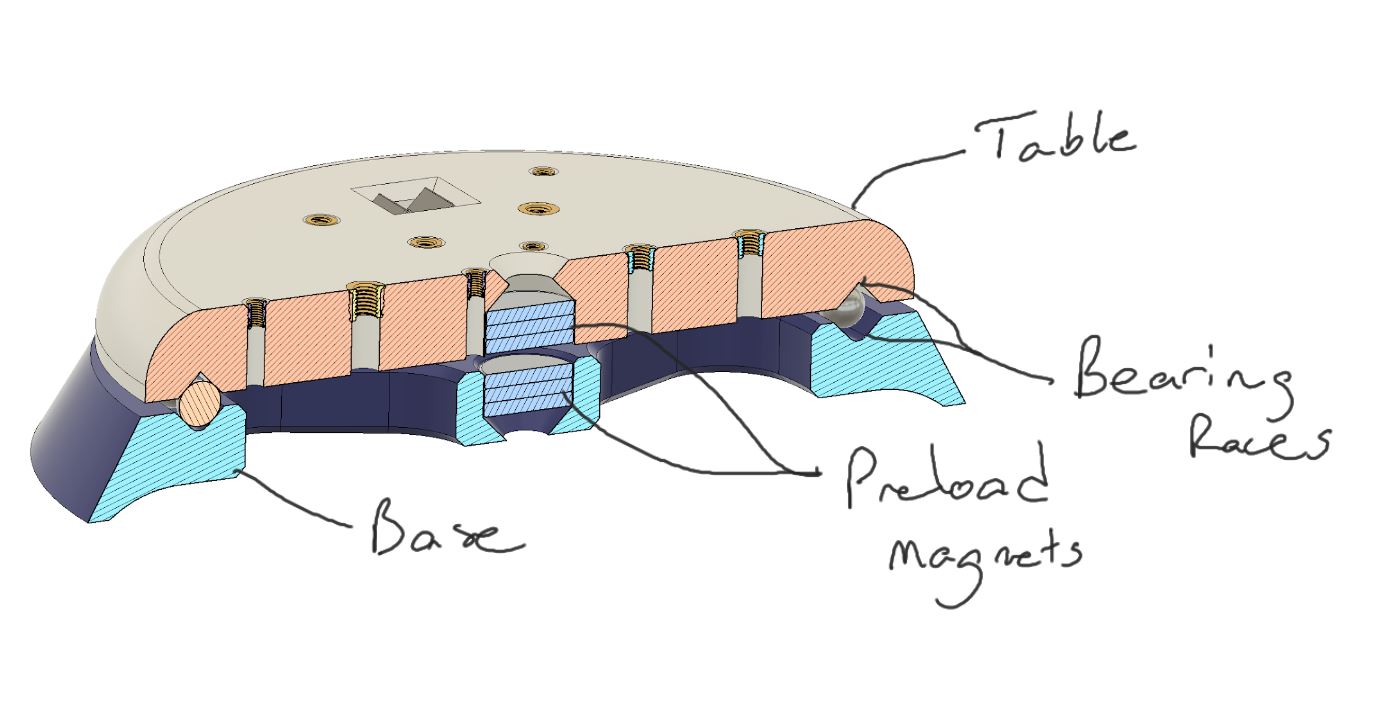 |
Assembly Tips
First and foremost, KEEP TRACK OF YOUR MAGNET POLES! Few things more frustrating that waiting for the parts to print, the glue to dry, your fingers to separate...and then floating mount.... Don't do it, definitely a check thrice, glue once situation.
Once everything has had plenty of time to cure and dry, I clean the surfaces of the kinematic mount magnets to ensure there's no left over CA muckin up ma mount. I just take some of those long q-tips, sorry, "Cotton Swabs", and some acetone and dip, wipe, repeat until there's no residue left and I've got nothing but nice, shiny neodymium.
Paper Towel Adapter
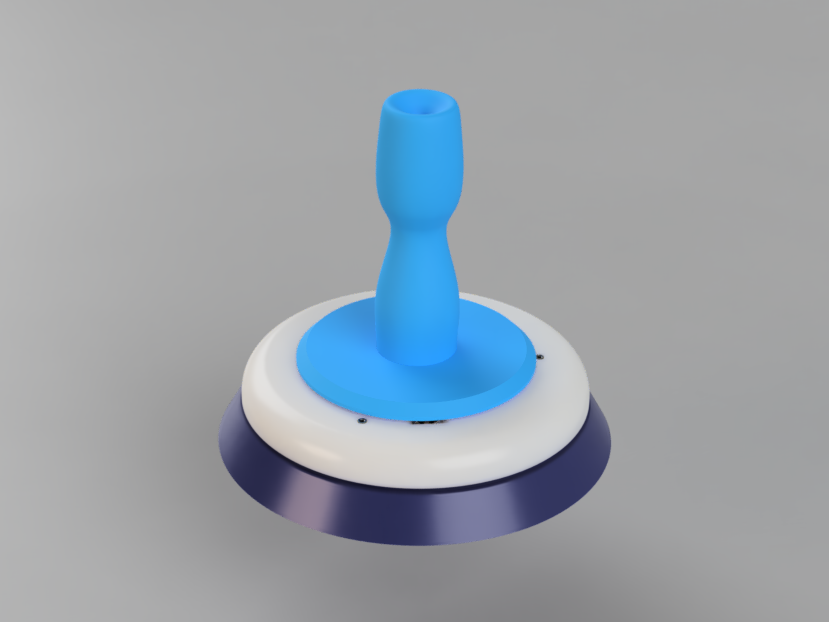 |
 |
If you really want to flex your love of determinism, have I got the paper towel holder for you! This paper towel holder adapter uses the kinematic mount points of the turntable. Finally, a paper towel holder with a central axis that's stable despite CTE differences...amma right???
Curious about the...interesting...shape of the towel holder itself? There is actually a reasoning behind the bizarre choice of contour. There are two functional (or allegedly functional) drivers for this geometry. The first is that I wanted to try to define the contact regions with the paper towel tube, so the concave regions top and bottom result in two lines of contact with the paper towel roll at those two heights....for those precision engineering nit-pickers, yep, it's overconstrained....paper towels ¯\_(ツ)_/¯ The second reason is to introduce some compliance to account for variations in paper towel roll sizes (at least within a range), since a full roll has quite a bit of hoop stiffness (resistance to growing in diameter...ish). So as you can see in the cross section below, the contact regions have a variable thickness.
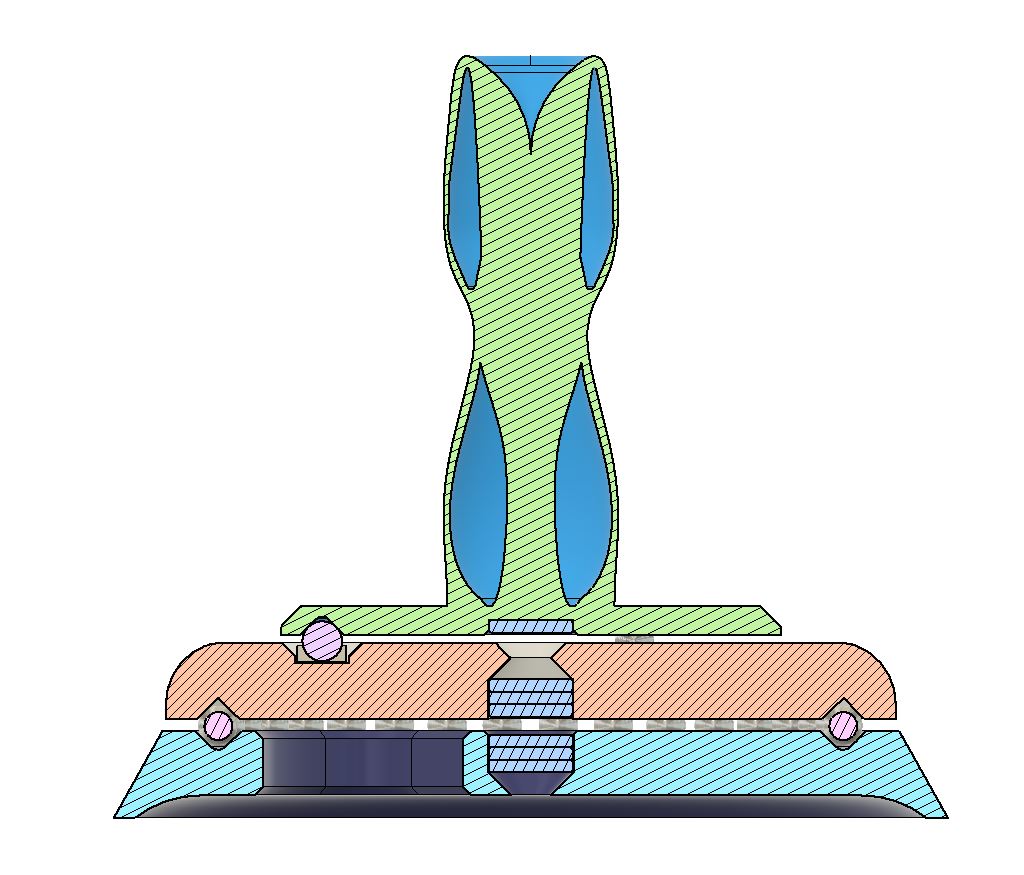
The original plan, and the first version I made, was for this to be a TPU component, but I've since printed it in PETG and it works just dandy. The TPU version does have a much better 'feel', in my opinion, but I'll gladly take the printing speed of PETG over the slight increase in enjoyment when swapping paper towel rolls. But if you want to really showcase the 'compliant mechanism' aspect, TPU is definitely the way to go.
- 2020 Aluminum Extrusion stuff
- Desktop stands, holders, and the like
- Hooks and Hangers
- Assorted Frame-making Hardware
- P&L Flipper Billiards
- Prusa Bed Camera Mount
- Generative Design Caliper Stand
- Generative Design SD Card (and Guitar pick, it turns out) Holder
- HydroHub - 4 in / 4 out distribution hub
- High Flow Peristaltic Pump
Subcategories
Assorted (hopefully) "Useful Stuff" Projects Article Count: 12
Like the bucket of assorted fasteners on that bottom shelf, this category is for stuff that I didn't know how to group...oh, and speaking of those fasteners, check out the little sortin fella!
2020 Aluminum Extrusion Hardware
|
Quick Bolt Sorter
|
General Purpose Turntable - Gen1

Games Article Count: 1
Generative Design Projects Article Count: 3
During the good financial decision-making times of Covid lockdowns, etc. I decided it was a good idea to buy a license for the Fusion360 Generative Design extension...Good news, I did finally pay that off :) I had worked around, and been somewhat involved in a handful of Topology Optimization/Generative Design projects through my work, and I've found the tech super interesting for some time. So after the free trial, and feeling like I was just starting to gain some level of competence in Fusion360's tool....I done did it, and bought the year. Ok, now that I'm done justifying that to myself...I mean you...
<engineering/design> What I really like about Generative Design is that it forces the designer to think about the thing they are trying to design from it's core requirements: Forces, Interfaces, and Keep Outs. I think it's far from perfect, especially given the still very primitive Design For Manufacture capabilities these tools have (among other shortcomings, but this one is certainly a big one to me.)
<precision engineering> One last also (for now), but ALSO, what I find exciting about these tools from a precision engineering perspective, is that the above-mentioned focus on forces and interfaces, these tools are extremely well-suited to kinematic/exact constraint designs! I think every one of the Generative Design projects below features at least some aspects of kinematic constraint (I say, "I think" because I may or may not be writing this before I go through my files and remind myself what all I actually made vs what I just thought about making ¯\_(ツ)_/¯ )
JFS Projects Article Count: 14
AgTech (aka finding a way to complicate and digitize gardening) Projects Article Count: 12
Hydration and Hydroponics Projects Article Count: 8
Peristaltic Pumpin Article Count: 4
A lot of projects I work on/have worked on seem to involve the controlled movement of fluids. Below is a bit of a history of my builds involving attempts at obtaining this controlled movement for incompressible fluids. I haven’t done much myself with making custom solutions for the compressible stuff, but if you’re interested in such things, I thoroughly enjoy Major Hardware’s “Fan Showdown” series :)
This article/section is by no means intended as a thorough overview on the design and operation of pumps. While I will try to give some overview on operating principles and design considerations as I go, this is mainly just going to be a wander through my personal builds and experiences.
Peristaltic Pumps
What is a peristaltic pump?
I’m sure there are innumerable sources online for (much better) detailed discussions of the workings of peristaltic pumps. So I’m just going to hit the highlights, and I’ll try to remember to find some promising links and add them below, should a deep dive seem intriguing to ya.
Basic Operation:
The fluid being pumped is carried into the pump in a compliant tubing. This tube is routed around some portion of a circular/cylindrical path around the axis of the pump and then exits the pump. This is one interesting/attractive aspect of peristaltic pumps, the fluid never has to leave the tube that it is in, making these pumps well-suited to situations where contamination and/or leaks are highly undesirable. The housing that features the cylindrical wall that the tubing is being routed along can be considered the Stator, and that is generally the nomenclature that I tend to use.

So if there’s a Stator, there must be a Rotor…? Yup, the rotor includes some set of features that extend out to some defined gap between this feature and the Stator wall. These features, which in many peristaltic pumps are rolling element bearings, pinch the tubing to the point of sealing (ideally) the tube. As the rotor turns, this contact point proceeds around the circumference. Because the pinched point of the tube is sealed, the volume of fluid in the tube ‘ahead’ of the pinch point are, as a result, pushed forward. So, keep rotating, keep pushing….pretty much as simple as that!
Pros:
- Positive Displacement Pump
- Because the pinch point is (ideally) fully sealing the tubing, the amount of fluid moved is directly proportional to the movement of the pump. This makes them very good choices for things like dosing pumps or other applications where the desired volume of fluid to be moved needs to be deterministic.
- This is a large driver for my initial interest in using peristaltic pumps. Their deterministic flow is/was very attractive for my plant growth experiments. They can give very repeatable watering volumes and nutrient concentrations.
- Fluid Isolation
- Because the fluid never leaves the tubing, these pumps can be suitable for moving hazardous materials. For example, I have been using a peristaltic pump for transferring 99% IPA
- Relatively Simple Construction
- Because the fluid does not have to be sealed within the pump, these pumps lend themselves well to DIY builds. No shaft seals, gaskets, etc. or complex (at least to do well) impeller design needed.
- Self-priming and Head height
- If well-sealed, these pumps are capable of self-priming (and even pumping air) and of achieving pretty impressive head heights (the measure of how high above the pump it can pump a column of water)
Cons:
- High drive torque
- Because of the preloading needed against the tubing, and the rolling friction, even with good rolling elements (more below on this), it can be quite easy to end up with designs that require quite a lot of drive toque.
- Tubing wear
- With the relatively large deformation and high number of cycles, the tubing will eventually fail, either due to material wear, fatigue cracking, or who knows what else. Because this failure mode can cause fluids leaking into your pump not designed to experience this fluid, this failure can potentially be quite problematic. So the use of high-quality tubing material and a plan for periodic maintenance, are worthwhile.
Test Build 1
A couple of years back, I had a concept for an in-line-mixing hydroponics system. The idea being that the supplies to the system would be just pure water and nutrient concentrates, and a series of pumps and valves would allow precise dosing mixes to each target plant in a system (I refer to this concept as Rail Yard Hydro, since it moves the fluids around the tubing network quite like rail cars are moved around a rail system. I’m planning to add a separate page diving into that one a bit deeper since it is the design scheme I am using in my current projects.)
Well, to facilitate this plan, I wanted to find an option for a dosing pump that I could integrate in to my control system (aka Arduinos and Raspberry Pi’s :)). Unfortunately, I quickly found that a servo-driven peristaltic pump could easily set me back north of $100….so I set out to spend many multiples of that making my own!
Actually, when I saw the pricing, I decided I should see if I could make myself a cheapo, manual version that I could use to just test out some basic questions on the Rail Hydro idea (mainly verifying that I could induce good material mixing in-line and that there was no cross-contamination between fluid reservoirs.) And so, ‘twas this endeavor that resulted in the pump I’m apparently referring to as “Test Build 1”
Design Objectives:
- Be a peristaltic pump
- Provide a full seal (at 100mm head)
- Be hand-cranked
- Not require any parts that would have to be ordered (I’m impatient)
The Build
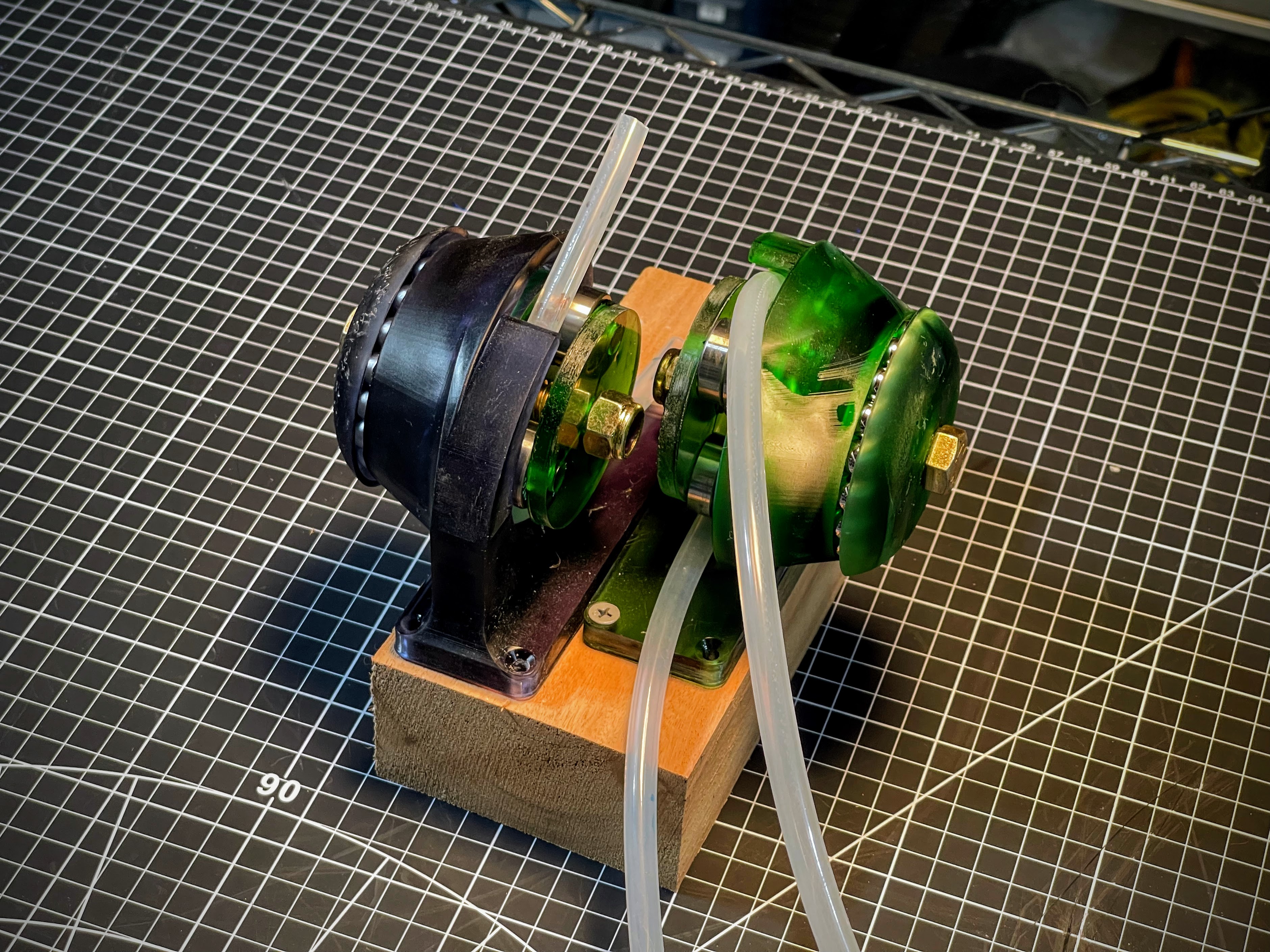
She ain't pretty (especially after a good while of getting knocked around), but the pic above shows the dual pump setup I rigged up for my testing needs. I was VERY pleasantly surprised that, other than a tweak to the hand wheel, these things worked pretty damn well!

I decided upfront that I was going to go with a resin printed build, because I thought the high stiffness and good surface finish throughout the 'pinch region' would give me a better chance. Since I was already going to have the good surface roughness, I might as well also integrate the main bearing into the printed parts.
In the image of the model, below, the Stator is the part shown in green, and the Rotor is shown in blue(ish.) Riding on the rotor are roller skate bearings to provide the contact with the tube. Race 1 has v-grooves on both sides of the race, providing the main constraint for locating the rotor, and Race 2 has a v-groove on the Stator, but only a single plane of contact on the Rotor side. This keeps from over-constraining the bearing.
 |
 |
The absurdly overkill bolt running through the center is a real showcase of "using what I had on hand" :) in that these were the only bolt/nut sets I had on hand with the length I was looking for.

